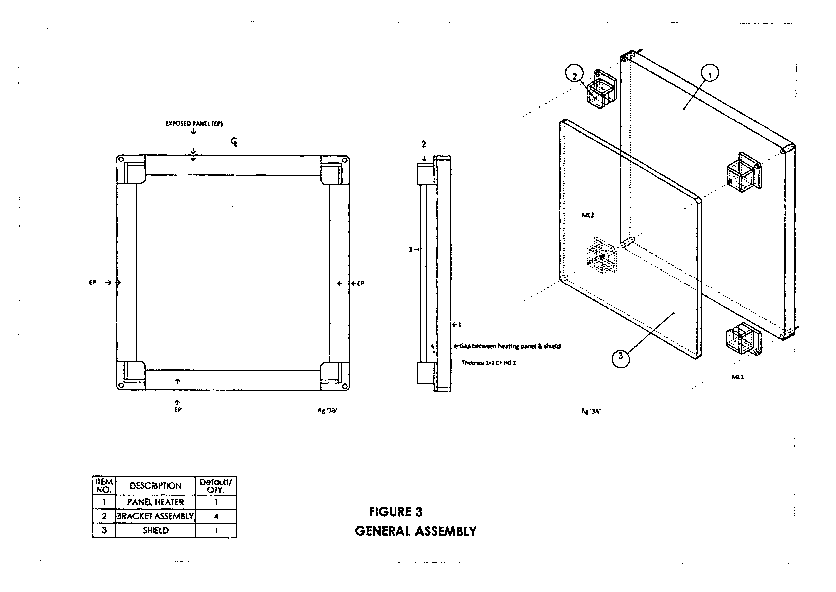Some of the information on this Web page has been provided by external sources. The Government of Canada is not responsible for the accuracy, reliability or currency of the information supplied by external sources. Users wishing to rely upon this information should consult directly with the source of the information. Content provided by external sources is not subject to official languages, privacy and accessibility requirements.
Any discrepancies in the text and image of the Claims and Abstract are due to differing posting times. Text of the Claims and Abstract are posted:
| (12) Patent Application: | (11) CA 2960586 |
|---|---|
| (54) English Title: | NOVEL METHOD OF SHIELDING HOT SURFACE AND IMROVING PANEL HEATERS |
| (54) French Title: | NOUVEAU PROCEDE DE PROTECTION DE SURFACE CHAUDE ET D'AMELIORATION DE PANNEAUX CHAUFFANTS |
| Status: | Deemed Abandoned and Beyond the Period of Reinstatement - Pending Response to Notice of Disregarded Communication |
| (51) International Patent Classification (IPC): |
|
|---|---|
| (72) Inventors : |
|
| (73) Owners : |
|
| (71) Applicants : |
|
| (74) Agent: | |
| (74) Associate agent: | |
| (45) Issued: | |
| (86) PCT Filing Date: | 2015-09-15 |
| (87) Open to Public Inspection: | 2016-03-24 |
| Examination requested: | 2017-03-16 |
| Availability of licence: | N/A |
| Dedicated to the Public: | N/A |
| (25) Language of filing: | English |
| Patent Cooperation Treaty (PCT): | Yes |
|---|---|
| (86) PCT Filing Number: | PCT/IN2015/000358 |
| (87) International Publication Number: | IN2015000358 |
| (85) National Entry: | 2017-03-08 |
| (30) Application Priority Data: | ||||||
|---|---|---|---|---|---|---|
|
Novel method of shielding hot surface and improving panel heaters (1). The method relates to new system of shield comprising of shield (3) and corner pieces (2) that not only cover the hot surface of panel heaters (1) but also facilitates second path of convection currents for space heating by maintaining optimum current space.
La présente invention concerne un nouveau procédé de protection de surface chaude et de perfectionnement de panneaux chauffants (1). Ledit procédé se rapporte à un nouveau système d'écran de protection comprenant un écran (3) et des pièces d'angle (2) qui non seulement recouvrent la surface chaude des panneaux chauffants (1) mais facilitent également un second chemin de courants de convection pour chauffer l'espace par maintien d'un espace de courant optimal.
Note: Claims are shown in the official language in which they were submitted.
Note: Descriptions are shown in the official language in which they were submitted.

2024-08-01:As part of the Next Generation Patents (NGP) transition, the Canadian Patents Database (CPD) now contains a more detailed Event History, which replicates the Event Log of our new back-office solution.
Please note that "Inactive:" events refers to events no longer in use in our new back-office solution.
For a clearer understanding of the status of the application/patent presented on this page, the site Disclaimer , as well as the definitions for Patent , Event History , Maintenance Fee and Payment History should be consulted.
| Description | Date |
|---|---|
| Application Not Reinstated by Deadline | 2018-09-17 |
| Time Limit for Reversal Expired | 2018-09-17 |
| Deemed Abandoned - Failure to Respond to Maintenance Fee Notice | 2017-09-15 |
| Inactive: Cover page published | 2017-08-16 |
| Letter Sent | 2017-04-11 |
| Inactive: Notice - National entry - No RFE | 2017-03-22 |
| Inactive: First IPC assigned | 2017-03-17 |
| Application Received - PCT | 2017-03-17 |
| Inactive: IPC assigned | 2017-03-17 |
| Correct Inventor Requirements Determined Compliant | 2017-03-17 |
| Inactive: Correspondence - PCT | 2017-03-16 |
| Request for Examination Requirements Determined Compliant | 2017-03-16 |
| All Requirements for Examination Determined Compliant | 2017-03-16 |
| Request for Examination Received | 2017-03-16 |
| Small Entity Declaration Determined Compliant | 2017-03-08 |
| National Entry Requirements Determined Compliant | 2017-03-08 |
| Application Published (Open to Public Inspection) | 2016-03-24 |
| Abandonment Date | Reason | Reinstatement Date |
|---|---|---|
| 2017-09-15 |
| Fee Type | Anniversary Year | Due Date | Paid Date |
|---|---|---|---|
| Basic national fee - small | 2017-03-08 | ||
| Request for examination - small | 2017-03-16 |
Note: Records showing the ownership history in alphabetical order.
| Current Owners on Record |
|---|
| VANGALA, PATTABHI |
| Past Owners on Record |
|---|